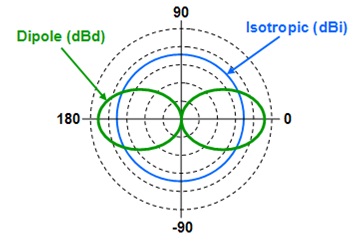Antenna Gain in LTE Antenna
Antenna gain is the ratio of the maximum radiation in a specified direction, a reference antenna in the same direction for the same power input. Usually, this increase links for isotropic antenna or dipole in free space half wave when 0° Height above sea level.
Null reference (dBi) usually refers to a theoretical antenna with Spherical radiation pattern with an equal gain in all directions. When used as a gain link, isotropic antenna has a power of 0 dBi. Half wave dipole (DBD) is antenna, which is a centre fed relatively equal current distribution in both halves. When used as a theoretical reference antenna, it has power gain 0 DBD, which equates to a 2.14 dB difference compared to isotropic antenna. The following figure depicts a graphical representation of the different models of antennas.

A collective ability is considered passive, power antenna, not added to, but simply redistributed to provide more radiated power in a particular direction, than could be transferred to isotropic antenna. If the antenna has a positive increase in some areas, It must have a negative gain in other areas, like energy is saved the dish.
The benefits that can be achieved by antenna is therefore a compromise between a range areas to be covered and the antenna gain. For example a dish MICROWAVE antenna for point to point will have great benefits, but only over the a very narrow vertical and horizontal beamwidth, as it must accurately pointed at each Endpoint.
Antenna for LTE site will have fewer benefits compared to microwave dish, as would be required to emit a broader way to provide coverage for many glasses (i.e. subscribers).
Amplification will influence other antenna characteristics such as size, weight, Horizontal beamwidth vertical beamwidth, and cost. RF engineer will need to select the antenna for your situation. The compromise would have to be concerning whether lower profits or higher antenna gain must be selected.
Higher gain antenna physically larger, usually more expensive and has a narrow vertical beamwidth would be lower than the antenna gain. Antenna Gain is a direct interaction with other antenna parameters .
Power Rating in LTE Antenna
Antenna power rating is the maximum power output, usually expressed in Watts the antenna will take place without degradation of performance. Typical values for power Rating antennas are between 300 and 500 watt. LTE 3 x 1 x 1 frequency reuse of single carrier would use and possibility of losses associated with merging with the existing premises of the carrier’s LTE legacy systems (GSM, CDMA, UMTS, etc), power antennas are not expected to be a limiting factor for antenna selection. Despite this, when selecting the antenna system engineer should consider expanding the system and theoretical maximum configuration of carriers that can be placed on a single antenna.
Antenna Polarization in LTE
LTE antennas used for wireless communications and other systems are either vertically polarized or cross polarized. Polarization is determined by the orientation of the electric field emitted by the antenna (E-plane). Cross polarized the antenna is actually two antennas, placed in the same panel antennas (i.e. accommodation).
Each antenna is polarized at 45° angle between the horizontal and vertical 90 degrees and polarized. The reason for this is un-correlated provide separation between the two antennas, so that they can be used to Receive diversity for MIMO. Cross polarization antennas can offer up to 25 DB isolation between the two antennas, while the real world rarely scattering This polarization change enough to take full advantage of the antenna design isolation.
How does the antenna gain affect the range?
The antenna gain is the measure of the antenna power in decibels (dB), which corresponds to 10 * log (Pout / Pin). Don’t worry, remember that the higher the gain, the more directional an antenna is – more range, narrower beam width. Every 6 dB increase in antenna gain should theoretically double the range.